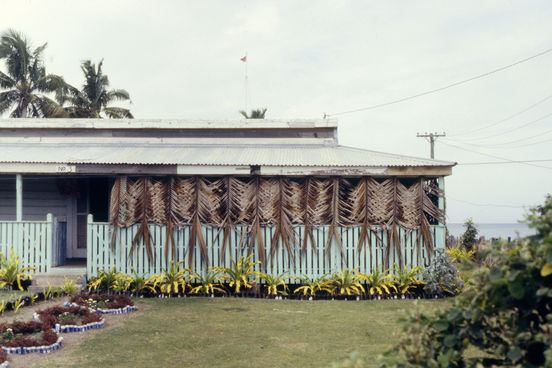Objectspace’s first exhibition at the Sir Miles Warren Gallery in Ōtautahi Christchurch is Oceanic Architectural Routes: The photographic archive of Mike Austin: Presented by Architectus. The inaugural exhibition in this new satellite space, Oceanic Architectural Route travels direct from its showing in Tāmaki Makaurau — the first stop on a national tour for this major show on Pacific architecture.
Oceanic Architectural Routes presents the photographic archive of Dr Mike Austin – images taken during his travels from the late 1960s to 2006 in Papua New Guinea, Solomon Islands, Fiji, Samoa, Tonga, the Cook Islands, Hawai‘i and Rapa Nui.
The photographs formed the basis for Austin’s architectural anthropology studies of house forms and cultures in the Oceanic region. They were also primary source materials for his popular courses ‘Oceanic Architecture’ and ‘People and Environment Studies’ at the University of Auckland School of Architecture from the 1980s until 1999, and in his later work as a supervisor of Pacific Master of Architecture students at Unitec and the University of Auckland.
The images and ideas seeded by Austin’s Oceanic architecture lectures quietly sprouted alternative roots in contemporary New Zealand architectural history. Some of these roots became routes (to borrow a metaphor from anthropologist James Clifford) – they enabled Pacific architectural customs and knowledge to connect with the vast reservoir of Indigenous knowledge worldwide, leading to the burgeoning interest in Pacific/Moana and Māori architecture today.
In the teaching of Austin, roots and routes are not separate but are entangled threads, continuities in transformation that are “rewoven and repeated”¹ in his studies, photographs and architectural practice. Numerous examples of this cut through this exhibition – from Austin’s studio teaching and the birth of the experimental pilot school The Brick Studio at the Auckland School of Architecture in the 1970s; the rerouting of architectural anthropology via ‘Oceanic Architecture’ in the 1980s; and the weaving together of critical theory, Pacific architectural modernity and Indigenous knowledge from 2000 onwards. Plans for the exhibition spurred on the digitisation of Austin’s archive, propagating future opportunities for the photographs to circulate and educate.
It is not surprising that for Austin, an experienced sailor, architecture in the Pacific is intimately connected to both land and sea – the land for roots to take hold in, and the sea for routes of ideas and relationships to extend and connect.
¹ James Clifford, Returns: Becoming Indigenous in the Twenty-First Century, Harvard University Press, 2013. Clifford originally used his roots/routes metaphor to describe the legacy of Epeli Ha‘uofa.
—
Dr Mike Austin has made a significant contribution in the research and understanding of buildings, architecture and culture of Oceania and the Pacific. Austin began teaching at the University of Auckland School of Architecture in 1969 after working in the architectural office of Newman, Smith & Greenough. His PhD in 1976 supervised by Gerhard Rosenberg, Polynesian Architecture in New Zealand, was the first serious study of Māori and Pacific architecture. From that time Austin has focussed on a syntactical understanding of the language and development of architecture in the Pacific region. He taught from 1969 until 1999 at the University of Auckland and was Head of Architecture at Unitech Papua New Guinea in 1987 before taking a position as Professor of architecture at Unitec in 2000.
Leali’ifano Dr Albert L. Refiti (Samoa: Fasito’outa, Vaovai, Vailima) is Associate Professor of Art and Design at Auckland University of Technology. He is co-editor of The Handbook of Contemporary Indigenous Architecture (2018) and Pacific Spaces: Translations and Transmutations (2022). He is a co-leader with Tina Engel-Schwarzpaul and Layne Waerea of the Vā Moana Research Cluster at AUT University and is currently conducting research funded by the Royal Society Marsden Fund on the history of architecture in Te Moananui with Rau Hoskins.
—
This exhibition is supported by Architectus, Noel Lane Architects and Vā Moana Pacific Spaces.
Objectspace at the Sir Miles Warren Gallery is supported by The Warren Trust, Christchurch City Council, Cemac Commercial Interiors, Te Kāhui Whaihanga New Zealand Institute of Architects, Athfield Architects and Karen & Hamish Doig.


Mike Austin, Bure, Vanua Levu, Fiji, 1973


Mike Austin, House Ha’apai, Tonga, 1983








